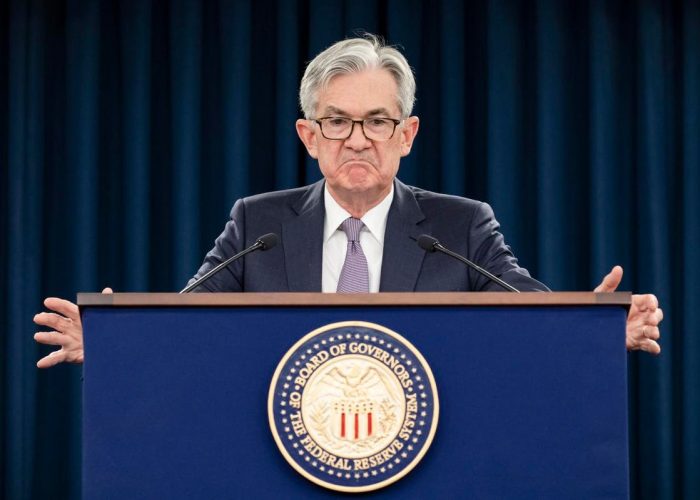Federal Reserve Board Chairman Jerome Powell speaks during a news conference after a Federal Open … [+] Market Committee meeting on January 29, 2020 in Washington, D.C.
Samuel Corum/Getty Images
Jerome Powell may think the Delta variant ruined his best-laid plans for the economy. The truth is, the Federal Reserve chairman lost control of his super-aggressive policies long ago.
Japan shows why.
In early 2021, as the U.S. vaccination process ramped up, talk at Fed headquarters in Washington was about exit strategies from a dozen years of Japan-like monetary easing. With inflation heating up, what choice did the Fed have? Then a new Covid-19 variant flipped the script.
Yet Powells desire to normalize U.S. rates was doomed even before the pandemic arrived.
Theres precedent just in the last 15 years that explains why. The Fed in 2021 is more or less where the Bank of Japan was in 2006, back when Tokyo policymakers tried their hand at tapering, tighteningand then ultimately failing to normalize the interest rate environment.
The details differ greatly, of course. In 2006, there was no pandemic tearing through the global economy. But thats when the BOJ decided that seven years of zero rates was long enough. It was also the moment Tokyo decided five years of pioneering quantitative easing was plenty.
Then-BOJ Governor Toshihiko Fukui headed for the exit gradually and methodically. After taking the helm in 2003, he began scaling back QE purchases. He began tapering. In July 2006, he pulled off a quarter of a percentage point rate hike. And a second tightening move by early 2007.
Then? The empire struck back. Lawmakers, bankers and corporate chieftains howled in protest that the central bank had yanked away the proverbial punchbowl. Once hints of slowing economic growth arrived, the knives were out for Fukuis BOJ. Amidst the bright hot spotlight and extreme scrutiny, Fukui dared not hike borrowing costs again.
The problem is how political, corporate and investment worlds effectively become addicted to free money. Before they realize it, zero rates are factored into business plans, debt management projections and investment strategies. Banks come to rely on free money and elected officials become very prickly about being deprived of unlimited liquidity.
Fukuis experiment with normalizing BOJ-driven credit growth was over by 2008, when he was replaced by Masaaki Shirakawa. As the Lehman shock shook world markets, Shirakawas first act was slashing rates back to zero. And his replacement, Haruhiko Kuroda, turbocharged things beginning in 2013.
Haruhiko Kuroda speaks during his regular press conference at the BoJ headquarters in Tokyo on … [+] October 31, 2019.
STR/JIJI PRESS/AFP via Getty Images
This is an admittedly circuitous way of saying Powell is trapped. Despite the inflation scares of recent months, Powell understands the mutually-assured-destruction dynamic that greatly limits his tightening options.
Well before he arrived at Fed headquarters, the 2013 Fed taper tantrum panicked the global financial system. Since then, the Fed has delved deeper than ever into government bonds and stocks via exchange-traded funds. And U.S. Treasury securities have become even more of a linchpin of global finance.
U.S. government debt is the cornerstone financial asset held by banks of all size, insurance companies, local governments, companies, pensions, endowments, pensions, universities, postal systems and, of course, retirees.
Its not unreasonable to think of the Powell Fed as playing the worlds biggest and most precarious game of Jenga. As if seeks to remove one blocksay, reduced ETF purchasesit risks wrecking the whole game. And when you consider that faith in the dollar and U.S. Treasury debt is essentially propping up global finance, theres little room for error.
In late 2015, the Janet Yellen-led Fed tried to pull off a Fukui BOJ maneuver. Like her predecessors in Tokyo, Yellen steered the Fed through wrapping up QE, tapering and then the first rates hikes in nine years.
When Powell arrived in 2018, he stayed the course. That is, until Donald Trumps Twitter feed intervened. Amid a blizzard of harsh rhetoric and termination threats from the then president, Powells team slashed rates anew. QE was back and more aggressive than ever as Covid-19 hit.
Powells push into uncharted territory makes it harder for the Fed to find its way out. Too many monetary Jenga pieces will require study and strategy to even consider removing any. Nor does the opacity of it all help.
The powerful Covid-19 stock rallies from New York to Tokyo make zero sense from a classical economic viewpoint. The missing piece is too much central bank cash chasing too few rational bets on companies and sectors in the social-distancing age.
Oddly, the dynamic that many investors see as irrationalcalm amid rising inflationmay be the only one that makes true sense. Few people would say 5% increases in consumer prices are a good thing. But the Delta-variant risk lent credence to the view that inflation is transitory. And that the real risk is weak inflation.
Doesnt Japan know it? Granted, Japan faces a more complicated economic equation. Much of its deflation is about demographics. An aging and shrinking population buys fewer new homes, cars, electronics and apparel than those with sizable ranks of twentysomethings and thirtysomethings.
Still, the Powell Fed is quickly realizing its stuck. It wont even get the chance to brainstorm with monetary experts from around the world this weekend, when the Fed had planned to hold its annual Davos-for-central-bankers retreat in Jackson Hole, Wyoming. Thanks to Delta, its now been deflated to a Zoom call.read more
Why Jerome Powell Could Be Trapped At Zero For Years


